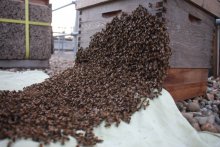A very tricky catch for Colony 20
I was called on 24th June to see a swarm in 2 parts on a tree. The tree was on raised land next to the canal towpath in Jericho, Oxford. There was no hives nearby so I suppose it came from the Cripley Meadow Allotments which are reasonably nearby.
The swarm had formed in 2 places in the tree. By the time I saw it, it had joined into one fair sized swarm at the whippy top of the tree and was in accessible. Next morning it had fallen out of the tree and was all over the ground.
- Read more about A very tricky catch for Colony 20
- Log in or register to post comments
